QuailFarms.Live,Hyderabad-9989669261
Japanese Quail Rearing – A Profitable Venture
November 5, 2022
312
Share

Japanese Quail Rearing – A Profitable Venture
Praveen, PhD Scholar
Department of Livestock Production Management
ICAR, National Dairy Research Institute- Bengaluru
Abstract
Nowadays J. quail rearing has become an emerging venture in the field of poultry industry because of disease resistant, early age at maturity with the egg laying happens in 30-42 days of hatching of chicks. Quail is zoologically called as Coturnix coturnix japonica with chromosome number 78. They will sexually mature at the age of 6-7 weeks. Different strains has been developed in CARI institute for egg, meat and dual purpose. The housing, feeding, breeding and brooding management of J. quail is detailed here.
Key words: egg, fast growth, pebbles, quail, sexing
Advantages of rearing quail
- Minimum space for rearing
- Small capital investment and cheap to rear
- Early sexual maturity
- Quail meat is tasty than chicken and low fat content
- Promote body and brain development in young ones
- Quail egg (3-4 times) far better than chicken egg with low cholesterol
- Quail droppings has high fertilizer value which will increase the crop yield
- As they are naturally disease resistant, they no need of requirement of vaccination and much medication.
Quail breeds developed
- CARI uttam – Broiler quail (220g)
- CARI pearl – Layer quail (290 eggs)
- CARI Brown
- CARI Ujjawal – white breasted
- CARI Sweta – White feathered
- CARI Sunheri – brown feather with white breast
Housing of quail
Mainly two types of quail housing
- Deep litter
- Battery system
Deep litter
In this type of housing 6 quails can be reared in 1 Square feet and after 2 weeks of age of quail , cage rearing is best in order to get increased body weight gain. Litter material is used as bedding for quail in deep litter system
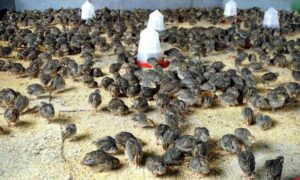
| Requirement | 1-3 week | Adult |
| Feeder/bird | 2 cm | 2.5-3.0 cm |
| Waterer | 1 cm | 1.5-2.0 cm |
| Light | 24 hrs | 12 hrs |
| Laying nest | – | 5-6 / bird |
| Floor space (cm2) | 150 | 200-250 |
READ MORE : बटेर पालन: एक लाभकारी उद्यम
Deep litter system is advantageous for layers where increase in percentage of laying, egg number, egg weight, yolk index, albumen index and shell thickness is noticed.
Battery cage
Each battery unit is 6 feet in length, 1 foot in width and has 6 subunits. It can be with 6 tiers height with 4-5 cages in a row. Bottom of the cage with removable wooden plates in order to remove droppings periodically to prevent disease spread. Feed trough should be long and narrow and to be kept in front of cage and water trough to be at the back of the cage. Commercial layer can accommodate 10-12 birds per cage and breeder can accommodate 1:3 ratio of male and female per cage.
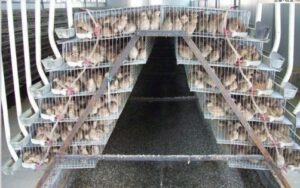
| Age | Space | No. of Bird |
| 1-2 wk | 3 X 2.5 X 1.5 feet | 100 |
| 3-6 wk | 4 X 2.5 X 1.5 feet | 50 |
Cage system is advantageous for broilers in which increase in bodyweight, increase in FCR and increase in dressing percentage is evident.
Sexing of quail
Sexing is difficult at day old
| Male | Female | |
| Plumage colour @ 3 week | Rusty brown breast feather (only few speckles) | Tan (grey) and speckled breast feathers |
| Cloacal gland (after sexual maturity) | Present (secretes a foamy material) | Absent |
| Vent sexing (4-5 weeks of age) | Squeezing the vent, milk colour semen will discharge from phallus | Nil |
| Body size | Lighter than female | Heavy |
| Sound | Loud call/ crow at maturity | Quiet nature |
Foamy material helps to protect the sperm once they have transferred into the hen.
Care of breeding quail
Quails breed in all the season. Sex ratio is maintained at 1:2 for good fertility. After the introduction of the male to female flock, fertile eggs can be collected form fourth day onwards. Optimum fertility is upto 8 m of age or less. Hatchability of fertile eggs rapidly declines when eggs are collected from older females. However, this effect is not observed in males. Egg laying usually takes place in evening hours at nearly 6.30 to 7.30 pm and the colour of egg be seen as mottled with black, brown or blue.
READ MORE : IMPORTANCE OF QUAIL EGG
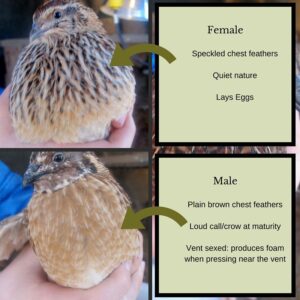
Care of hatching eggs
Quail eggs are thin and so to be handled carefully. Eggs to be kept in atmosphere free of dust. Eggs can be stored to a maximum of 7 days at the temperature of 14-160C with relative humidity @ 70 to 80%
Natural incubation
It can be done by broody hen since quail is not a natural hatcher. Hatchability percentage with broody hen will be 50-90% and better hatchability can be obtained with 20-25 eggs per incubation. The survival rate of chicks born by broody hen incubation is about 65-95 %
Advantage
- Reduce drudgery
- Reduce extra stress
- Minimise transport and breeding cost of the eggs
- Time saving
Death of the chicks born of broody hen may be due to stamping by hen, so chicks to be removed quickly after hatching, low temperature and parasitic infestation
Artificial hatching
Hatching takes place in 17-18 days in which 6-7 g chicks comes from 10g egg. Eggs to be turned at 4-6 times per day upto 14 days of hatchery
| Temp | RH | |
| Setter | 37.2˚ C | 60% |
| Hatcher | 36.9˚ C | 70% |
Brooding management of quail
Quail chicks to be brooded upto 4 week of age either in deep litter or battery cage (reduction in mortality). Floor space for brooding to be hover space @ 75 cm2/Chick and run space @ 75 cm2/Chick. Marble or pebbles to be placed in the waterer in order to prevent drenching of the quail chick and the pebbles can be removed after 2 weeks of brooding. Temperatue of the brooder house at 1st week maintained at 370C and reduce 2.70C per week upto 28.90C (4th week).
READ MORE : CARE OF ORPHAND NATIVE BIRDS
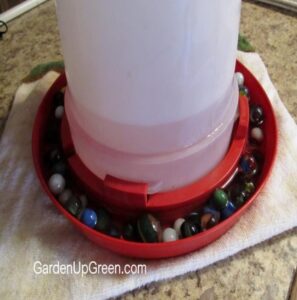
Feeding management
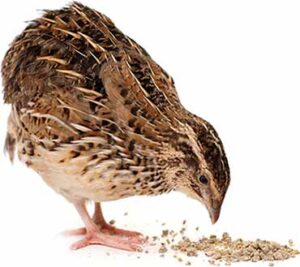
| Nutrients | Starter(0-3 weeks) | Grower(4-6 week) | Layer(>7 week) |
| ME (Kcal/kg) | 2750 | 2750 | 2650 |
| Protein (%) | 27 | 24 | 22 |
| Ca (%) | 1 | 0.8 | 3.0 |
| P (%) | 0.45 | 0.45 | 0.45 |
Quail egg and meat nutrient
| Nutrient | Egg (%) | Meat (%) |
| Water | 74 | 73.93 |
| Protein | 13 | 20 |
| Lipid | 11 | 3.85 |
| CHO | 1 | 0.56 |
| Mineral | 1 | 1.12 |
| Calorie | 649 calorie |
Quail egg has 4 times more iron and phosphorus than chicken egg and the yolk albumen ratio is 39:6. Dressing percentage of meat is about 70-73%
Major diseases of J. quail
- Ulcerative enteritis: caused by Clostridium pericardium, perfringens. Mortality is about 100 % with the symptom of watery droppings. Post-mortem lesions were ulcer in intestine and cloaca
- Bronchitis : It has 80% mortality with symptom of tracheal rales, sneeze without nasal discharge
- Coccidiosis
- Aspergillosis
- Ranikhet disease
Hurdle in quail rearing
- Make more sound and disturb human
- If male and female together it will peck each other and egg production will decrease.
References
- Priti, mishra and Satish, shukla “Quail farming: An introduction”. Int. J. of Life Sciences. 2.2 (2014):190-193
- Akbar, M S ; Sreehari, s and Yadav, jeet singh “Rearing and production of quail”. Indian farming. 63.1(2013):21-22,28.
- Lata, kanak and Srivastava, R C “Feasibility of natural brooding of quail eggs by broody hen”, 2013:21-22,39.
- Kayastha et.al., “ Performance of japanese quail on different management system”. Indian J. Anim. Prod. Mgmt. 28.3(2013):218-222.
- Edwin, S C “ Profitable japanese quail rearing”. Poultry for sustainable food production and livelihood. Pg.No: 133-143
Please follow and like us:










- TAGS
- Brooding management of quail
- Care of breeding quail
- Care of hatching eggs
- Egg
- fast growth
- Housing of quail
- Hurdle in quail rearing
- Japanese Quail Rearing – A Profitable Venture
- Major diseases of J. quail
- pebbles
- Quail
- Quail breeds developed
- Quail egg and meat nutrient
- sexing
- Sexing of quail
Share
Previous article
Hyperbaric Oxygen Therapy in Pets: A Life-Saving Treatment
Next article
CONCEPT OF LIVESTOCK BASED GROUP FARMING OR COMMUNITY FARMING IN INDIA
Pashudhan praharee is the mouthpiece of Indian Dairy & Poultry industry, dedicated to the animal health care & livestock development.Our mission is to strengthen the animal husbandry practices in India and transfer the technologies from Lab to Land.
